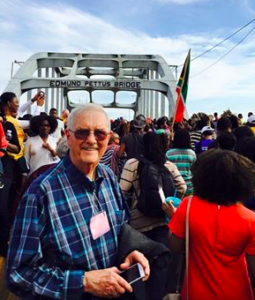Japan ICU Foundation Trustee Bill Lesher on Returning to Selma
The following article was written by Japan ICU Foundation trustee Bill Lesher. Bill will be completing his term as a trustee at the end of this month. His support and guidance over the years has been invaluable, particularly in the area he is most passionate about, interreligious understanding.

Crossing Over the Selma Bridge – Again
By: William E. Lesher
It was a beautiful day in Selma, Alabama. It was not unlike the day, 50 years ago, when I gathered with a group of about 2,000 marchers on the steps of Brown Chapel. We had come from every corner of the country and from every walk of life in response to Dr. Martin Luther King’s urgent plea to join him in an effort to pick up the march that had been violently ended on what has become known as ‘Bloody Sunday,” March 7, 1965. On that day, about two hundred, mostly African Americans set out on a 54-mile march from Selma to Montgomery, the Alabama State Capitol, to demand fair voting rights legislation. As they crossed the peak of the Edmund Pettus Bridge that led out of Selma and onto the highway, the marchers were driven back by Alabama State Troopers on horseback wielding batons and brutally beating the marchers in the melee. It was this unbelievably shameful sight, vividly captured on T. V., that together with King’s plea compelled us to drop everything and congregate in this small, out-of-the-way, rural, southern town.
The scene in front of Brown Chapel on the 50th Anniversary weekend, March 7-8, 2015 was strikingly different. Civil Rights dignitaries, celebrities, federal, state and local officials processed out of the church guarded by Alabama State Troopers. They made their way down a cordoned off pathway through the crowd and then led the way to a ceremonial crossing of the notorious Edmund Pettus bridge. An estimated 80,000 people crowded every street in this small town, all literally inching toward the bridge. Again, marchers came from every corner of this nation and from other nations as well. Many were white-headed veterans of the earlier marches, but many more were people of all ages, all religions and all races. Some were pushing strollers, others wheelchairs. There were old people hobbling on canes and walkers and young people dancing their way up and over this bridge of sighs, that has been transformed into a bridge of hope.
At the very base of the bridge, before the steep ascent to the peak, a large video screen portrayed a steady stream of key moments in the civil rights struggle. Often the unmistakable voice of Martin Luther King boomed out over this huge crowd, as it did so often in the past, urging marchers on; “If you can’t run then walk, if you can’t walk, crawl, but keep on moving toward justice.”
The day before this mass Anniversary March Presidents Obama and Bush, together with one hundred members of Congress commemorated the heroic Selma Voting Rights Movement with an unprecedented visit to Selma. At the base of the bridge, President Obama delivered an address that members of both parties have called one of his finest. Among many memorable lines is this one that weaves together the significance of the sacrifice at Selma with the highest form of patriotism and the empowerment of successive generations to correct current and future flaws in our nation. “What could more profoundly vindicate the idea of America than plain and humble people— the unsung, the downtrodden, the dreamers not of high station, not born to wealth or privilege, not of one religious tradition but many — coming together to shape their country’s course? What greater form of patriotism is there than the belief that America is not yet finished, that we are strong enough to be self-critical, that each successive generation can look upon our imperfections and decide that it is in our power to remake this nation to more closely align with our highest ideals?”
In many ways the civil rights movement of the 1960’s was an earlier expression of the interrelgious movement today. Both are visionary, persistent and determined efforts to transform the human race into the human family.



